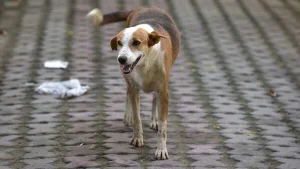New Delhi – The Supreme Court will pronounce its crucial decision tomorrow regarding pleas to stay the controversial directions passed on August 11 for removing stray dogs from Delhi National Capital Region to shelter homes. A three-judge bench comprising Justice Vikram Nath, Justice Sandeep Mehta, and Justice NV Anjaria heard the matter that has sparked intense debate about animal welfare and public safety.
The Supreme Court Stray Dog Order has created unprecedented tension between animal rights activists and public safety advocates. The case took a dramatic turn on August 13 when the suo motu case relating to stray dogs was shifted to the current three-judge bench after lawyers mentioned before the Chief Justice that the original directions conflicted with previous orders from other benches.
Original Bench Directions Under Scrutiny

The original Supreme Court Stray Dog Order was passed by a two-judge bench comprising Justice JB Pardiwala and Justice R Mahadevan on August 11. The bench took suo moto cognizance of a news report about stray dog incidents affecting children in Delhi, leading to comprehensive directions for immediate action by authorities.
On August 14, the three-judge bench heard arguments on whether to stay the August 11 directions and reserved its order. The Supreme Court Stray Dog Order remains in limbo as stakeholders await clarity on its implementation, with animal welfare organizations and municipal authorities preparing for different scenarios depending on tomorrow’s decision.
Comprehensive Shelter Infrastructure Requirements
The Supreme Court Stray Dog Order mandates that the State of NCT of Delhi, Municipal Corporation of Delhi (MCD), and New Delhi Municipal Corporation (NDMC) immediately establish dog shelters and report infrastructure creation across Delhi within eight weeks. These shelters must maintain sufficient personnel for sterilized and immunized stray dogs while ensuring detained dogs are not released into streets, colonies, or public places.
The Supreme Court Stray Dog Order requires CCTV monitoring to prevent unauthorized release or removal of dogs from shelters. As a progressive measure, authorities must begin with shelters accommodating 5,000 dogs within six to eight weeks, with capacity expansion planned over time to address the growing stray dog population effectively.
Immediate Capture and Relocation Directives


Under the Supreme Court Stray Dog Order, NCT Delhi, MCD, and NDMC must immediately begin collecting stray dogs from all localities, particularly vulnerable areas and city outskirts. The order empowers authorities to create specialized forces for this purpose, emphasizing that making localities free of stray dogs should be the foremost priority without compromise.
The Supreme Court Stray Dog Order warns against resistance from individuals or organizations, stating that any interference with stray dog collection efforts will result in contempt proceedings. The bench emphasized that larger public interest considerations drove these directions, prioritizing child safety over other concerns.
Child Safety and Rabies Prevention Focus


The Supreme Court Stray Dog Order specifically addresses infant and young children’s vulnerability, stating they should not fall prey to rabies under any circumstances. The court emphasized that actions should inspire confidence that people can move freely on roads without fear of stray dog bites, declaring that no sentiments should interfere with this essential exercise.
The Supreme Court Stray Dog Order establishes clear priorities: public safety, particularly child protection, takes precedence over other considerations. The bench made it explicit that this represents the first step in a comprehensive process to address Delhi’s stray dog crisis systematically.
Record Maintenance and Monitoring Requirements
The Supreme Court Stray Dog Order directs MCD, NDMC, and appropriate authorities in Noida, Ghaziabad, and Gurugram to maintain detailed daily records of stray dogs captured and housed in shelter homes. These records must be produced during subsequent hearings, ensuring transparency and accountability in implementation efforts.
Crucially, the Supreme Court Stray Dog Order prohibits releasing any captured stray dogs from shelters, warning of stern action if violations occur. This no-release policy represents a significant departure from previous catch-neuter-release programs, focusing instead on permanent shelter accommodation.
Emergency Response and Healthcare Coordination
The Supreme Court Stray Dog Order mandates creating a helpline within one week for reporting dog bite incidents. Authorities must capture reported dogs within four hours of complaints, with strict warnings against interference from individuals or organizations. Any obstruction will be treated as contempt of court.
Captured dogs under the Supreme Court Stray Dog Order must be sterilized and immunized according to regulations but cannot be released under any circumstances. Additionally, authorities must coordinate with medical facilities to ensure immediate treatment for bite victims, with detailed reports required for court review.
Vaccine Availability and Medical Preparedness
The final aspect of the Supreme Court Stray Dog Order addresses vaccine availability concerns, directing authorities to provide detailed information about available vaccines, stock levels, and persons seeking treatment. This comprehensive approach ensures medical preparedness matches the scale of the stray dog removal operation.
The Supreme Court Stray Dog Order represents an ambitious attempt to balance public safety with systematic animal management, though tomorrow’s decision will determine whether this controversial approach continues or faces modification based on constitutional and practical considerations.

